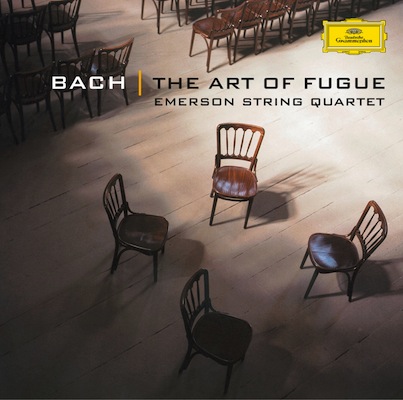Contrapunctus I From the Art of the Fugue Ww Norton

The Emerson String Quartet: J.S. Bach, The Fine art of the Fugue, BWV 1080
CD Deutsche Grammophon 474 495-two
(Streaming via Tidal; no hullo-res download appears available.)
Recorded January and February 2003 at the American Academy of Arts and Messages, New York City. Da-Hong Seetoo, producer and engineer.
1 of the bits of musical not-trivia that I have carted effectually me for ages is the fact that American composer Roy Harris (whose third symphony is for me the best case of mid-twentieth-century, typically exuberant American musical creativity) also, with collaborator M.D. Herter Norton transcribed for string quartet Bach'due south The Art of the Fugue.
One thousand.D. Herter Norton, by the way, was Margaret (too sometimes Mary; and, informally Polly) Dows Herter, who with her hubby W.Westward. Norton founded the publishing firm that bears his name. (W.W. Norton is still a major publisher—if not the major publisher—of music-history texts and anthologies for higher use in the English-speaking world.) Margaret Norton was a violinist, an contained scholar of music, and translator from the German language of about a dozen volumes of the verse of Rainer Maria Rilke. She was very of import in the early on years of the American Musicological Society, equally well as co-authoring, editing, or translating manufactures for the The Musical Quarterly.
Afterward the jump, there is a scan of the cover of that score, from 1936. And generous sound samples. I call up most music lovers will find this CD (or the stream from Tidal) extremely rewarding.

As a practical matter, the options to performThe Fine art of the Fugue in the modern era include piano, harpsichord, or organ; or some instrumental ensemble. (OK, I estimate the Swingle Singers could vocalize information technology–but would you actually want to listen to 70 minutes of that?).
Piano is monochromatic; harpsichords can be jangly; organs are generally found in churches; and mixed instrumental ensembles' tonal distinctions can over-emphasize differences while underplaying the commonality of the musical lines. Whereas a string quartet'south shared tone color can lend a transparency to the texture of the scoring and provide supple residual to the interweaving musical lines. The liner notes to the Emerson Quartet's CD do not credit the transcriber, and so nosotros can assume that this was non played from the Harris/Herter Norton score.
There is no question that the Emerson Quartet idea very deeply near every aspect of this music, to the extent of reversing the seating of the quartet for the inverted portion of the mirror canons, and having the 2nd violin play viola (and the violist play tenor viola), so that low notes in some numbers that are non available to their usual instruments can be heard. Also important to point out is that several of the numbers (iii out of 21) are played as cord trios (as was the example in the Harris/Herter Norton score). This lends both variety, and even greater transparency. I constitute the trios to be the about affecting parts of the recording.
J.Due south. Bach left off working onThe Art of the Fugue because of sick health and encroaching blindness. Therefore, the final fugue in the manuscript ends all of a sudden. There is a story that on his deathbed, Bach dictated revisions to his chorale "Wenn wir in höchsten Nöthen sein" to brand upwardly for the unfinished nature of the score. That tradition is followed here. It goes without saying that the string playing is earth-class; very clear in timbre just non sounding cold, with pristine, not-Romanticized execution. The soundworld is (at least for me) very easy to go into. Chamber-scaled Bach on string instruments tuned to modernistic concert pitch of A = 440Hz is non jarring. After all, the string-quartet form did not be in Bach's lifetime.
The recorded sound is splendid, and the liner notes enviably complete. Well done all around.

My recommendation is that all serious classical-music lovers buy this CD. Peradventure emblematic of the parlous country of the classical-recordings business, when y'all buy the concrete CD from Amazon (at the very reasonable cost of $14.12), you besides get a free MP3 download. And at that place is streaming via Tidal for the merely curious.
Sound samples:
1 Bach/ The Art Of Fugue, BWV 1080 – Contrapunctus 1 first
viii Bach/ The Art Of Fugue, BWV 1080 – Contrapunctus 8 start
12 Bach/ The Fine art Of Fugue, BWV 1080 – Contrapunctus 14A (Canon per Augmentationem in Contrario Motu) end
xviii Bach/ The Art Of Fugue, BWV 1080 – Contrapunctus 13A commencement
19 Bach/ The Art Of Fugue, BWV 1080 – Contrapunctus 13B kickoff
21 Bach/ The Art Of Fugue, BWV 1080 – Contrapunctus 14(18)/ Fuga a 3 Soggetti end
22 Bach/ The Fine art Of Fugue, BWV 1080 – Chorale/ Wenn Wir in Höchsten Nöten Sein kickoff
# # #
Source: https://thetannhausergate.com/index.php/2016/11/11/emerson-quartet-j-s-bach-the-art-of-the-fugue/
0 Response to "Contrapunctus I From the Art of the Fugue Ww Norton"
Postar um comentário